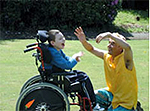Disability dance

Also known as ‘Dance and Disability’ or ‘Interactive Creative Dance Movement’ or ‘Integrated Dance’ or ‘Dance Differently’ or ‘Community Dance’.
I specialise in the therapeutic use of dance. I work with children and adults who have a wide range of needs including complex additional support needs, mental health support and behavioural difficulties. I have found that working through dance with people who have additional support needs leads to a great number of benefits. These include:
- Increased body awareness
- Feeling more centred/grounded
- Increased self confidence
- Increased self esteem
- Being able to relax and feel good about themselves
- Enhanced creativity and use of imagination
- Opening up and releasing emotions
- Building trust in self and others
- Increased understanding of movement
- A strengthened link between body and mind
- Improved connection with others
- Increased awareness and respect of others physically and emotionally during contact
Over the last 4 years I have used dance therapeutically with people with disabilities in 27 different organisations
Sue Dodds, Consultant in Music for Special Education: “Charan is unique. He is gifted, a true professional and a very special person. His very special and unique approach means that he reaches and bonds with each person he works with. Once they have met him, they never forget him, always recognising him as soon as they see him again, no matter what the time lapse. They will smile if you mention his name and beam with happiness at the sound of his voice. The trust he inspires means they will try things they have never done before. They know he will walk with them on their creative journey. They know he will delight in their achievements. And believe me, they do achieve! It is an honour and a pleasure to work with Charan, knowing we are always working towards the same goal.”
Dance movement workshops are designed specifically for the special needs of the group, be they limited by movement, visual impairment, wheel chairs, or learning difficulties. Participants’ feedback and their mood on the day shape the sessions. I meet the group in advance to hear how they would like to benefit from the workshop. Where appropriate I work closely with carers on the session objectives and involve them closely in the sessions to enhance continuity and provide them with a learning opportunity.
Case Study: Two Special Schools In Central Scotland
Charan worked one day a week with both the whole school towards a show at the end of term one and then with individuals. He choreographed the show piece in collaboration with Sue Dodds, Consultant in Music for Special Education. In the second term he worked with individual children who were deemed ‘difficult’ and ‘hard to reach’. He also facilitated weekly dance movement sessions along with musician colleagues on the innovative 2-year Tapestry research project.
Depute head teacher: “It has been a very uplifting and inspiring experience – the creative aspects of the programme ‘tune in’ to each child’s individual needs and personality. We have seen remarkable responses from some of the children which we could not have predicted.” Sheila Harknes
Teacher: “The experience of using movement and dance has been an excellent opportunity for children of all abilities within the school – the children were greatly enjoying as well as learning from the experience.” Marion Craig
Case Study: Interactive Creative Dance at Queen Margaret Hospital
Charan facilitated a weekly creative dance class for people with and without disabilities. Participants explored their own movements and learnt how to combine them with others to create new movements and compositions. Participants built trust, increased self-awareness and developed appreciation of others. No previous experience was necessary – the requirement was just to come with an open heart and a desire to experiment.
